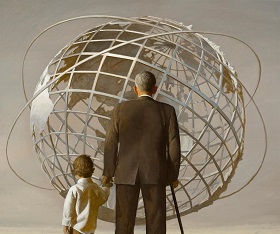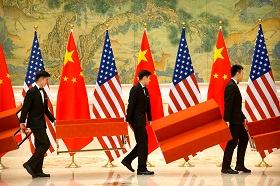What is Multilateralism in European Terms?
(votes: 4, rating: 5) |
(4 votes) |
Ph.D. in History, Academic Director of the Russian International Affairs Council, RIAC Member
The term “multilateralism” is not specifically elaborated in Russian international relations theory. For a long time, it has remained in the shadow of the much more popular term "multipolarity," although the latter is gradually being replaced in Russian literature by the term "polycentrism.” Sometimes, it seems that “multilateralism” and “multipolarity” are used in Russian scientific and political discourse as synonyms, both reflecting the democratisation of the international system that began with the collapse of the “unipolar world” at the beginning of the century.
Yet, “multipolarity” is obviously not the same as “multilateralism.” The former denotes pluralism in the distribution of power in the international system among three or more independent decision-making centres, while the latter describes a possible way for these centres to collaborate. Without multipolarity, there can be no multilateralism, since a unipolar or bipolar system simply does not provide enough actors for multipolar interaction. But multipolarity does not necessarily imply multilateralism, since relations within a multipolar system can theoretically come down to a set of bilateral relations between individual centres of power.
In the United States, at least prior to the Trump administration, multilateralism was formally considered the preferred foreign policy practice, especially in relations with allies. For example, NATO is a multilateral military-political alliance and the North American free trade area (NAFTA, recently superseded by USMCA) is a multilateral trade and economic integration initiative. Yet, the United States has acted as the undisputed leader in all multilateral agreements, which has raised questions as to how multilateral these agreements really are. As for Donald Trump, he has expressed doubt as to whether Multilateralism Is an effective means for promoting American interests at all, preferring, wherever possible, to negotiate with partners in a bilateral format.
Unlike the United States, EU countries consider multilateralism not only a convenient format for foreign policy but one of its fundamental principles. This principle is embedded in many official EU documents, including the Treaty on the European Union (Article 21). The commitment to multilateralism was once again reaffirmed last spring when France and Germany announced the creation of the international Alliance for Multilateralism, already joined by about fifty countries from various regions of the world. “Multilateralism” in European political discourse is, however, often little more than a uniting slogan, representing one of the basic values of the European Union that distinguishes the EU from other global players who prefer a unilateral foreign policy (USA, Russia, China).
That is why the essay Multilateralism: Variants, Potential, Constraints and Conditions for Success, authored by one of the pillars of modern German foreign policy thought, Professor Hanns Maull, and published by the German Institute for International and Security Affairs (SWP), merits careful reading. For over twenty years, Hanns Maull has held the Foreign Policy and International Relations Chair at the University of Trier in Germany and is now a professor at the Johns Hopkins University in Bologna. Let us discuss the main points of his essay.
The essay by Hanns Maull leaves us with the feeling that only the very first steps have been taken so far in studying the complex problems of multilateralism and the number of questions that arise significantly exceeds the number of available answers. In any case, it seems obvious that multilateralism (just like, for example, multipolarity or polycentricism) can in no sense be considered a universal mechanism for resolving all international problems. The multilateral format, as the author rightly notes, has many significant drawbacks: it is cumbersome, complex, slow and often has disappointing results. Multilateralism cannot and will not replace the bilateral approach and unilateral foreign policy actions.
Even so, one may agree with the author that multilateralism has its obvious comparative advantages. It would be a mistake to ignore or downplay such features of multilateralism as democratism, representativeness and the legitimacy and sustainability of the results of multilateral negotiations. Multilateralism Is a chance for relatively weak players to make their voices heard and their interests taken into account. It is also an opportunity for relatively strong players to make their leadership more civilised, less burdensome and less intrusive for all other participants in the international scene.
Ultimately, however, multilateralism, like any other format of diplomatic activity, will always be as effective or ineffective as the players who practice them want. So far, most of these players are guided by an understanding of multilateralism somewhere between Multilateralism II and Multilateralism I, gradually sliding from the first to the second. Reversing this negative trend to start moving towards Multilateralism III will require tremendous efforts.
The term “multilateralism” is not specifically elaborated in Russian international relations theory. For a long time, it has remained in the shadow of the much more popular term “multipolarity,” although the latter is gradually being replaced in Russian literature by the term "polycentrism.” Sometimes, it seems that “multilateralism” and “multipolarity” are used in Russian scientific and political discourse as synonyms, both reflecting the democratisation of the international system that began with the collapse of the “unipolar world” at the beginning of the century.
Yet, “multipolarity” is obviously not the same as “multilateralism.” The former denotes pluralism in the distribution of power in the international system among three or more independent decision-making centres, while the latter describes a possible way for these centres to collaborate. Without multipolarity, there can be no multilateralism, since a unipolar or bipolar system simply does not provide enough actors for multipolar interaction. But multipolarity does not necessarily imply multilateralism, since relations within a multipolar system can theoretically come down to a set of bilateral relations between individual centres of power.

Why the World is Not Becoming Multipolar
In the United States, at least prior to the Trump administration, multilateralism was formally considered the preferred foreign policy practice, especially in relations with allies. For example, NATO is a multilateral military-political alliance and the North American free trade area (NAFTA, recently superseded by USMCA) is a multilateral trade and economic integration initiative. Yet, the United States has acted as the undisputed leader in all multilateral agreements, which has raised questions as to how multilateral these agreements really are. As for Donald Trump, he has expressed doubt as to whether multilateralism is an effective means for promoting American interests at all, preferring, wherever possible, to negotiate with partners in a bilateral format.
Unlike the United States, EU countries consider multilateralism not only a convenient format for foreign policy but one of its fundamental principles. This principle is embedded in many official EU documents, including the Treaty on the European Union (Article 21). The commitment to multilateralism was once again reaffirmed last spring when France and Germany announced the creation of the international Alliance for Multilateralism, already joined by about fifty countries from various regions of the world. “Multilateralism” in European political discourse is, however, often little more than a uniting slogan, representing one of the basic values of the European Union that distinguishes the EU from other global players who prefer a unilateral foreign policy (USA, Russia, China).
That is why the essay Multilateralism: Variants, Potential, Constraints and Conditions for Success, authored by one of the pillars of modern German foreign policy thought, Professor Hanns Maull, and published by the German Institute for International and Security Affairs (SWP), merits careful reading. For over twenty years, Hanns Maull has held the Foreign Policy and International Relations Chair at the University of Trier in Germany and is now a professor at the Johns Hopkins University in Bologna. Let us discuss the main points of his essay.
Interpretations of the Term
The author of the essay offers the reader three levels of understanding of multilateralism. The first level of understanding, designated by Maull as Multilateralism I, reduces this concept to diplomatic interaction between three or more states (or other actors) in international politics. This understanding does not present any difficulties or controversies: multilateralism comes down to formal issues and is contrasted to unilateral and bilateral formats. Nor does this understanding offer any substantive content: participants in the multilateral format can pursue any goals and base their cooperation on any principles that suit them. From the essay, we may conclude that, for example, the three agreements made in the second half of the 18th century between Russia, Prussia and Poland on the partition of the Polish–Lithuanian Commonwealth fall well under the definition of multilateral diplomacy, since all three parties participated in all the agreements.
Modern German foreign policy employs a broader interpretation of multilateralism, designated by the author as Multilateralism II. The essence of the German understanding is that multilateralism, in addition to formal criteria, should also include substantive criteria. Therefore, it includes interaction of more than two actors with action within the framework of international organizations, oriented towards the principles and norms and carried out in accordance with the rules and regulations that underlie those organisations (such as, for example, the United Nations Charter). In this version, a multilateral foreign policy stands not only for a specific diplomatic approach but also for a commitment to certain principles, substantive goals and methods of foreign policy. Ultimately, we are talking about a limited set of common values that do not exclude conflicts between individual participants. A possible example of Multilateralism II is probably the way European countries cooperated within the framework of the Conference on Security and Cooperation in Europe (CSCE) in the 1970s and 80s, while maintaining a mostly competitive relationship between two different social and political systems.
Historically, this understanding of multilateralism is closely connected with the concept of the Western liberal world order, the foundations of which were laid in 1945 and which began to claim universality after 1990. Yet, this does not mean that Multilateralism II must inevitably disappear along with the decaying liberal world order. It may be based on other values and principles; the main element is the creation of common norms in world politics, to be agreed in a multilateral format. In fact, multilateral mechanisms should enable us to agree on common norms and values, a universally desirable world order and regulatory practices acceptable to each individual participant in multilateral negotiations.
Multilateralism III represents a more radical understanding of the term. Whereas the main task of Multilateralism II is to achieve the broadest possible compromise on the basic issues in the regulation of international life, despite significant differences in the interests of the participants, Multilateralism III is to find “right” or “appropriate” solutions to the problems of world politics, i.e., achieve a transition to "effective global governance." If Multilateralism II proceeds from what the participants in the system think achievable, Multilateralism III operates in terms of what is desired and what should be done. In the first case, we are talking about a tactical alliance of players with very different aspirations and, in the second case, about a strategic partnership of like-minded parties who interact with one another to achieve common goals.

A New Anarchy? Scenarios for World Order Dynamics
Accordingly, in order to move from Multilateralism II to Multilateralism III, two complex problems must be resolved. First, tactical allies should become strategic partners, that is, agree on a general picture of a desirable future, on practical steps to make this future possible, on an equitable distribution of the burden and costs associated with this transit, etc. Second, international institutions must be established that are capable of ensuring effective coercion of independent players in the international system to implement multilaterally adopted decisions. As history shows, for example, in the case of multilateral efforts to combat climate change, even a general agreement on the principles, values and goals of cooperation does not necessarily guarantee that the international community will move towards its stated goals.
Why is a “Multilateral” Foreign Policy Necessary?
Proponents of multilateralism (any of the above variants) rely in their reasoning on three interrelated assumptions: regarding the magnitude of impending global challenges; the persistence of a trend toward power diffusion in world politics; and the great potential of multilateral cooperation.
The first assumption, according to Maull, needs no detailed justification. Some of the global challenges — from climate change and a possible environmental disaster to uncontrolled development of new technologies and the threat of a global nuclear war — call into question the continued existence of mankind. Another thing is equally obvious: many of these challenges place extremely high demands on the quality of global governance, including not only cooperation between states but also involvement of non-state players — private businesses, international organisations and civil society. Constructive co-operation, even between such large states as China and the United States, will not in itself suffice to solve the problems. Within the framework of today’s predominantly Westphalian international system, achieving a new quality of global governance does not appear feasible.
Power diffusion is likely to continue. Consolidation of the world based on a revival of a unipolar or even rigid bipolar system seems unlikely. Nation-states will remain the main players in world politics, with preservation (at least formally) of the principles of sovereignty and territorial integrity. At the same time, the number and international activity of non-state players will continue to grow, undermining the hierarchy in world politics and economics. Traditional formats of international cooperation will increasingly prove ineffective and the need for complex new multilateral and multi-level formats will grow. A multitude of multilateral schemes crop up in international relations, which could not have existed even theoretically throughout human history.
Proponents of multilateralism suggest that the transition to a new level of global governance will make it possible to use resources more efficiently, streamline strategies and priorities, avoid duplication of efforts, etc. Maull, however, entertains serious doubts about this assumption. First, transferring even some of the functions of national states to multilateral structures is already difficult since the states themselves have long become much less omnipotent on their own territory. Second, the effectiveness of existing multilateral structures — from the United Nations and the European Union to the International Monetary Fund and the World Bank — is also controversial. Global governance based on multilateralism has yet to prove its worth.
Multilateral Diplomacy: Benefits and Challenges
The obvious advantage of multilateral diplomacy, according to the author, is its inclusive nature: only multilateralism allows the broad coalitions necessary for resolving complex problems to be formed. In addition, multilateralism enhances the international legitimacy and sustainability of any agreements. Of course, this only applies to situations when the multilateral coalition is sufficiently representative, that is, when the problem is solved bearing in mind the positions and interests of all significant players.

Between Polycentrism and Bipolarity
On the other hand, it is precisely these features of multilateral diplomacy that, in some cases, turn out to be its downfall. It can be difficult to focus the agenda in multilateral negotiations, as each of the participants has its own priorities. Multilateral negotiations usually require more time and resources than bilateral ones, not to mention unilateral actions. Procedural issues are much more difficult to negotiate in a multilateral format than a bilateral one.
Decisions made following multilateral negotiations often turn out to be half-hearted, fuzzy and declarative, as negotiators focus on the search for the “lowest common denominator,” allowing them to keep the support of the maximum number of contracting parties. Multilateral negotiations can be blocked by any of the participants. There is an inverse proportion between legitimacy and effectiveness: high legitimacy is achieved at the cost of low effectiveness and vice versa. The same correlation usually applies to the time needed to reach an agreement and its stability: agreements concluded in a scramble are generally less stable and reliable than ones resulting from lengthy negotiations.
As a general rule, we can conclude that multilateral and representative formats have no alternative when it comes to fundamental systemic problems in world politics or economics. Even so, when it comes to the need to respond quickly to a sudden challenge, the actions of small groups of players who are more interested in solving the problem may be more effective. Of course, you have to pay with a part of legitimacy for efficiency and effectiveness.
There are many other problems and difficulties associated with multilateralism. For example, it is not entirely clear how to distribute the responsibilities and burdens associated with implementing an agreement “fairly” among all the participants in multilateral negotiations. The question of what measures should be taken with respect to those who take a selective approach to multilateral agreements or even sabotage their implementation is also not a simple one.
In multilateral negotiations, mutual confidence between participants is more critical than in bilateral negotiations because there is always a fear that groups of participants might coordinate their negotiating positions behind the scenes so that the others will have to face a consolidated opposition promoting unilateral interests in a coordinated manner. Digressing for a moment from the discussion of Maull’s essay, we may note that it was precisely such a problem that arose in the work of the Russia–NATO Council, established at the NATO–Russia Summit in Rome in May 2002. The Russian side proceeded from the Council becoming a fully-fledged multilateral organisation with each participant acting in its individual capacity. Western countries turned the Council into a mechanism for bilateral cooperation between NATO and Russia, de facto abandoning the principle of multilateralism. A similar situation arose over time in the Group of Eight, after it was joined by Russia. On many fundamental issues, Moscow was forced to confront a combined coalition of the other seven members of the G8. The transformation of a formally multilateral format into a virtually bilateral one significantly reduced the effectiveness of the two negotiation platforms, both for Russia and, ultimately, for its Western partners.
Conditions for Effective Multilateralism

Illusions of a New Bipolarity
Given the above problems, we can formulate several conditions that might allow multilateral negotiation to be successful. These conditions relate mainly to the approaches and expectations of negotiators. First, participants should be interested in achieving sustainable results, not winning a diplomatic “victory” over partners by securing tactical advantages. A diplomatic “victory” of this kind could undermine the agreement at some point and turn it into a defeat.
Second, participants must be orientated on compromise, including a willingness to make concessions. Practice shows that violation of a reasonable balance between concessions by the parties inevitably undermines the stability of the agreement.
Third, negotiators should proceed from the principle of “diffuse reciprocity,” that is, be prepared to demonstrate solidarity with partners in difficult situations, sacrificing their immediate interests for the sake of longer-term gain, if necessary.
Fourth, negotiators must have “internal legitimacy”, that is, be able to make commitments on behalf of those they represent. This means that only strong leaders with broad political support in their own countries can be successful negotiators.
Fifth, implementation mechanisms should be identified from the outset. If these conditions are not met, multilateral negotiations will prove useless at best and harmful at worst, acting as a smokescreen masking the unilateral actions of certain players.
vThe author emphasises that the success of multilateral diplomacy paradoxically depends on the willingness of participants to make unilateral and bilateral steps. Practice shows that, behind any success of multilateral efforts, there is always a leader or group of leaders who take the initiative in determining the agenda, prioritising its issues and maintaining the negotiation schedules, as well as acting as mediators in reaching a compromise. The multilateral format does not cancel out and will not replace the bilateral format but it is a necessary addition to or prerequisite for the latter. An example of such a combination is the bilateral German–French negotiations on creating the Alliance for Multilateralism.
Alliance for Multilateralism
The Alliance for Multilateralism, as an informal association of countries promoting multilateral approaches to resolving international problems, remains a flagship foreign policy project of Germany. Although this initiative has a very brief history, its work allows us to draw some conclusions about the possibilities and limitations of Multilateralism in world politics.
First of all, the initial meeting of interested countries was held on the sidelines of the UN General Assembly in New York in September 2019 by seven states: Germany, France, Canada, Mexico, Chile, Ghana and Singapore. These countries are very different in size, economic development and political systems. For example, according to the Freedom House classification, Mexico and Singapore are among the “partly free” countries. So we may conclude that the desire for multilateralism (perhaps even in the format of Multilateralism II) is not a feature inherent exclusively in liberal democracies.
In addition, the first practical steps made by the Alliance confirm the assumption that multilateral structures tend to focus on relatively uncontroversial, technical issues, where there is more chance of developing a common position. One such issue was the Alliance’s proposal to ban lethal autonomous weapons systems (even though the countries most actively working on such systems did not participate in the Alliance). More complex issues, such as freedom of trade, the future of international law and international organisations, human rights, etc., were left on the periphery of the Alliance’s attention. We should add that most of the decisions taken by the Alliance are to be implemented by the interested players on a voluntary basis.
Such a choice of priorities raises the fundamental question of whether the transition to a new level of global governance can go from bottom to top — from specific, depoliticised and relatively simple issues to more complex, sensitive and politically loaded problems, or whether it should go from top to bottom — from general, politically determined, fundamental problems to technical details. If we assume that a bottom-up transition is feasible, the Alliance’s work should be welcomed and supported in every way. If the only possible transition is top-down, then the Alliance’s work may even be counterproductive because it creates the illusion of moving forward where, in fact, no progress is being made. Replacing strict international legal rules with voluntarily assumed obligations, for all its attractiveness, can erode the foundations of the modern world order without creating any effective alternative.
It Is Not That Simple
The essay by Hanns Maull leaves us with the feeling that only the very first steps have been taken so far in studying the complex problems of multilateralism and the number of questions that arise significantly exceeds the number of available answers. In any case, it seems obvious that multilateralism (just like, for example, multipolarity or polycentricism) can in no sense be considered a universal mechanism for resolving all international problems. The multilateral format, as the author rightly notes, has many significant drawbacks: it is cumbersome, complex, slow and often has disappointing results. Multilateralism cannot and will not replace the bilateral approach and unilateral foreign policy actions.
Even so, one may agree with the author that multilateralism has its obvious comparative advantages. It would be a mistake to ignore or downplay such features of multilateralism as democratism, representativeness and the legitimacy and sustainability of the results of multilateral negotiations. Multilateralism is a chance for relatively weak players to make their voices heard and their interests taken into account. It is also an opportunity for relatively strong players to make their leadership more civilised, less burdensome and less intrusive for all other participants in the international scene.
Ultimately, however, multilateralism, like any other format of diplomatic activity, will always be as effective or ineffective as the players who practice them want. So far, most of these players are guided by an understanding of multilateralism somewhere between Multilateralism II and Multilateralism I, gradually sliding from the first to the second. Reversing this negative trend to start moving towards Multilateralism III will require tremendous efforts.
(votes: 4, rating: 5) |
(4 votes) |
Multilateralism Instead of Multipolarity
A New Anarchy? Scenarios for World Order DynamicsThe problem common to the Russian and US (Western) approaches is that they describe the past and may prove of little use for describing the present and the future
Between Polycentrism and BipolarityOn Russia’s World Order Evolution Narratives
Rethinking International Security for a Post-Pandemic WorldFor the first time in living memory, humanity is confronting a common threat that it must defeat collectively. It is time to start planning for when the eventual victory comes
Illusions of a New BipolarityWhen superpowers are not surrounding themselves with ideological blocs, bipolarity is nothing but two states getting into a bickering match, albeit with certain global attributes





